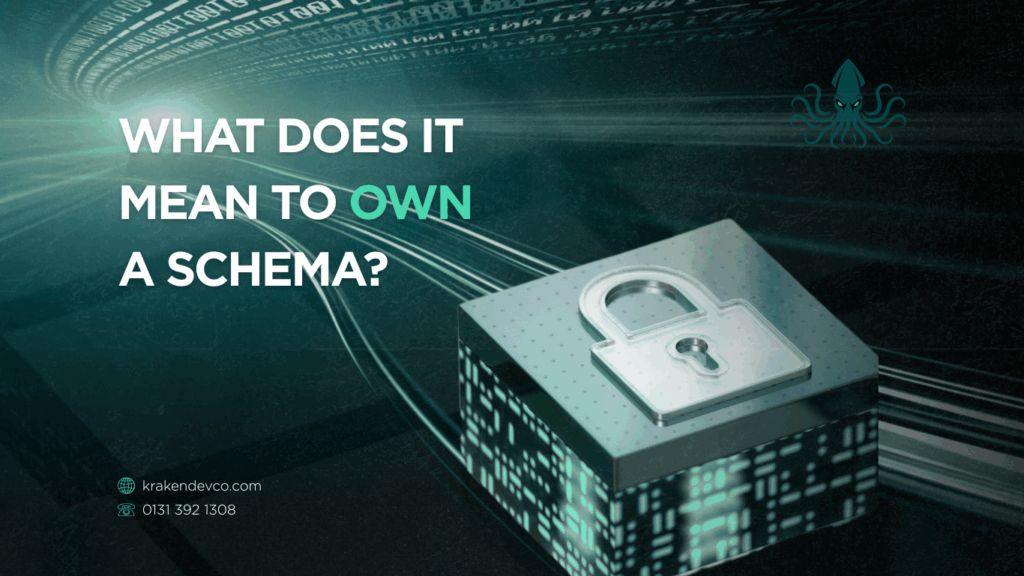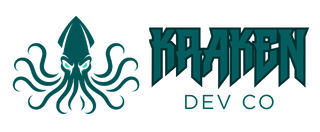
Ever had a deployment blow up because the database didn’t recognise the user?
It’s a familiar story: everything works in dev, it passes test… and staging crashes with a cryptic error about a missing user. No code changed. No infrastructure broke. So what happened?
Welcome to the silent failure mode of schema ownership.
At Kraken Dev Co, we help engineering teams build secure, scalable systems. And that means going beyond just writing code. It means managing the integrity of every layer—including your database schemas. In this blog, we’ll break down what it actually means to own a schema in SQL Server, why the defaults are dangerous, and how you can lock in safe, reliable schema strategies from the start.
What Is Schema Ownership—And Why Should You Care?
A schema in SQL Server is not just a folder. It’s a logical container for objects: tables, views, procedures, functions. But unlike a folder, it’s also a security boundary. Every schema must be owned by a database principal. That principal might be:
- A user account
- A database role
- A service principal used in automation
Whoever owns the schema has automatic, irrevocable permissions on all its contents. Ownership isn’t cosmetic—it governs access, deployment behaviour, and security chaining. And once set, ownership sticks until explicitly changed.
The Hidden Fragility of User-Based Ownership
Imagine this: Jane, a developer, creates a schema locally with her personal dev account:
sql
CopyEdit
CREATE SCHEMA SalesSchema AUTHORIZATION JaneDev;
It runs perfectly in development. Testing works fine too. Then staging crashes with:
“Cannot find the user ‘JaneDev’, because it does not exist or you do not have permission.”
Your options?
- Recreate Jane’s user in every environment (bad for security)
- Patch the ownership mid-pipeline (unscalable and error-prone)
Both are duct tape solutions. Neither belongs in production pipelines in 2025.
Default Ownership: Convenient, Until It Isn’t
SQL Server assigns ownership based on who creates the schema. If a sysadmin creates it, it defaults to dbo. That’s relatively safe. But developers with standard privileges? Their own accounts become the schema owner by default.
You end up with:
- Some schemas owned by dbo
- Some owned by individual devs
- Some tied to long-gone contractors
This isn’t just messy. It’s brittle. One missing user and your CI/CD pipeline halts.
How Schema Ownership Breaks Security Without You Noticing
SQL Server optimises access using a feature called ownership chaining. If every object in a chain—say a view, procedure, and table—is owned by the same principal, SQL skips redundant permission checks. This boosts performance and reduces friction.
But introduce mismatched ownership and that chain breaks. SQL Server now has to revalidate every access point. That leads to:
- Mysterious access denials for devs with “full” permissions
- Over-permissive access if roles are misconfigured
- Hours lost debugging “it worked on my machine” bugs
Broken chains cost you time, trust and security.
Legacy Schemas: A Cleanup You Can’t Keep Ignoring
SQL Server ships with built-in schemas like db_accessadmin, db_securityadmin, and others that reflect legacy database roles. These shouldn’t be part of modern schema strategy.
Unless explicitly needed for backwards compatibility, remove them:
sql
CopyEdit
IF EXISTS (SELECT * FROM sys.schemas WHERE name = N’db_accessadmin’)
DROP SCHEMA [db_accessadmin];
You can’t drop schemas that contain objects or system schemas like dbo, sys, or INFORMATION_SCHEMA. But everything else? Clean it out. Keep your schema model lean, clear, and relevant.
dbo: Use With Precision, Not Laziness
Developers default to dbo because it “just works”. But this causes problems:
- Audit trails disappear
- Permissions get muddled
- Performance suffers due to default schema assumptions
Use dbo for shared infrastructure—jobs, utilities, logging—but not for domain-specific objects. Always assign schemas with a purpose, tied to a clear ownership model.
How to Do Schema Ownership the Right Way
You need a schema strategy that’s:
- Consistent across environments
- Easy to audit
- Durable through team changes
- Secure by design
1. Use Service Principals or Roles—Never Individual Accounts
Set ownership using a neutral principal:
sql
CopyEdit
CREATE SCHEMA AppSchema AUTHORIZATION AppOwner;
In dev, impersonate the owner:
sql
CopyEdit
GRANT IMPERSONATE ON USER::AppOwner TO [DevUser];
This decouples schema structure from human accounts and scales safely.
2. Set Ownership at the Point of Creation
Never rely on patching ownership after the fact. Define it cleanly upfront.
sql
CopyEdit
— Don’t do this unless you’re fixing a legacy schema
ALTER AUTHORIZATION ON SCHEMA::AppSchema TO AppOwner;
Prevention is better than remediation.
3. Use Roles to Manage Developer Access
Avoid binding permissions directly to usernames:
sql
CopyEdit
ALTER ROLE db_owner ADD MEMBER Developer;
This supports team churn and avoids breakages when someone leaves.
4. Use dbo Deliberately—Or Not At All
If you know the implications and need shared access, dbo is fine. Otherwise, don’t default to it. Create schemas like BillingSchema, ReportingSchema, or APISchema tied to appropriate roles.
The Real-World Cost of Ignoring Ownership
We’ve seen schema ownership issues cause:
- Failed deployments in CI/CD
- Inconsistent permissions across environments
- Security audits filled with manual overrides
- Fragile test environments
- Downtime at scale
These issues aren’t hard to prevent—but they’re painful to fix. And they waste time that your dev team could be using to ship.
Schema Design and Ownership Go Hand in Hand
Clean schema boundaries mean nothing without stable ownership. And tight ownership loses value if schema logic is chaotic. You need both. Together, they define how your database works, how it scales, and how quickly you can onboard new engineers.
Structured schema ownership directly impacts:
- Security inheritance
- Query predictability
- Audit clarity
- Deployment stability
It’s part of your database contract. Treat it like any other critical dependency.
Pro-Level Tips That Actually Work
From engineers who’ve lived through it and built around it:
- Use dbo sparingly
- Assign ownership to service principals, not people
- Standardise schema ownership across environments
- Document every ownership assignment
These aren’t advanced tactics. They’re the new baseline. And they’ll keep your database from becoming the weakest link in your infrastructure.
Your Schema Should Never Be a Liability
Database fragility is a silent cost. Schema ownership is often the culprit. At Kraken Dev Co, we help engineering teams identify and resolve these structural blind spots.
We audit your schema catalogue, align ownership, and stabilise your deployment processes. That’s not just good hygiene—it’s good engineering.
Own your schemas. Don’t let them own you.
Ready to Get Your Database in Shape?
If you’re seeing brittle permissions, broken pipelines or audit gaps, you’re already paying the price. Book a consultation with Kraken Dev Co and we’ll make your schema structure work as hard as your codebase does.
Visit krakendevco.com to take the next step.



